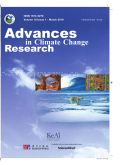- 钛学术文献服务平台 \
- 学术期刊 \
- 基础科学期刊 \
- 天文学、地球科学期刊 \
- 气候变化研究进展(英文版)期刊 \
Future changes of cluster high temperature events over China from RegCM4 ensemble under RCP4.5 scenario
Future changes of cluster high temperature events over China from RegCM4 ensemble under RCP4.5 scenario
基本信息来源于合作网站,原文需代理用户跳转至来源网站获取
摘要:
Using the daily maximum temperature of the RegCM4 dynamical downscaling from four global climate models under the historical and RCP4.5 simulations,this study firstly identified the cluster high temperature event(CHTE)occurring in China through a simplified objective method,and then projected its change during the 21st century in terms of the CHTE metrics including frequency,duration,extreme intensity,cumulative intensity,maximum influential area,average influential area,and comprehensive intensity.The ensemble projection indicates that all the CHTE metrics tend to increase toward the end of the 21st century on the national scale.Besides,the occurrence of CHTE shows a longer month span during the middle and the end of the 21st century(from April to October)compared to the present(from April to September),accompanied with the peaks of the frequency,duration,and cumulative intensity shifting from the present July ahead to June.Relative to 1986-2005,the projected slight,moderate,and extreme CHTEs increase by 55%,50%,and 50%(58%,43%,and 60%)during 2046-2065(2080-2099),respectively;the projected severe CHTE increases by 11%during 2046-2065 while decreases by 11%during 2080-2099.Spatially,the CHTE frequency,duration,and cumulative intensity are projected to increase in a widespread region.The largest increase appears in southern China for the frequency and in Xinjiang and Southeast China for the duration and cumulative intensity.We further divided China into five sub-regions to examine the regional features of CHTE changes.It is found that in addition to the increase of CHTEs in each single sub-region,a pronounced enhancement is also projected for the occurrence of cross-regional CHTEs,particularly for that across more than two sub-regions.

推荐文章
Thermodynamic properties of San Carlos olivine at high temperature and high pressure
San Carlos olivine
Thermodynamic property
Thermal expansion
Heat capacity
Temperature gradient
Projections of 2.0°C Warming over the Globe and China under RCP4.5
中国西北地区
全球变暖
预测
集合平均
全球平均气温
中高纬度地区
估计模型
表面温度
Ore genesis of Badi copper deposit, northwest Yunnan Province, China: evidence from geology, fluid i
Badi copper deposit
Fluid inclusion
Sulfur isotope
Hydrogen and oxygen isotope
Ore genesis
内容分析
关键词云
关键词热度
相关文献总数
(/次)
(/年)
文献信息
| 篇名 | Future changes of cluster high temperature events over China from RegCM4 ensemble under RCP4.5 scenario | ||
| 来源期刊 | 气候变化研究进展(英文版) | 学科 | |
| 关键词 | |||
| 年,卷(期) | 2020,(4) | 所属期刊栏目 | Changes in climate system |
| 研究方向 | 页码范围 | 349-359 | |
| 页数 | 11页 | 分类号 | |
| 字数 | 语种 | 英文 | |
| DOI | |||
五维指标
引文网络
引文网络
二级参考文献 (137)
共引文献 (40)
参考文献 (33)
节点文献
引证文献 (0)
同被引文献 (0)
二级引证文献 (0)
1982(1)
- 参考文献(0)
- 二级参考文献(1)
1990(1)
- 参考文献(0)
- 二级参考文献(1)
1991(2)
- 参考文献(0)
- 二级参考文献(2)
1993(2)
- 参考文献(0)
- 二级参考文献(2)
1994(1)
- 参考文献(0)
- 二级参考文献(1)
1995(1)
- 参考文献(0)
- 二级参考文献(1)
1996(1)
- 参考文献(0)
- 二级参考文献(1)
1997(2)
- 参考文献(0)
- 二级参考文献(2)
1998(1)
- 参考文献(0)
- 二级参考文献(1)
2000(3)
- 参考文献(0)
- 二级参考文献(3)
2001(1)
- 参考文献(0)
- 二级参考文献(1)
2003(2)
- 参考文献(0)
- 二级参考文献(2)
2004(3)
- 参考文献(0)
- 二级参考文献(3)
2005(3)
- 参考文献(0)
- 二级参考文献(3)
2006(4)
- 参考文献(1)
- 二级参考文献(3)
2007(6)
- 参考文献(0)
- 二级参考文献(6)
2008(7)
- 参考文献(1)
- 二级参考文献(6)
2009(11)
- 参考文献(0)
- 二级参考文献(11)
2010(7)
- 参考文献(1)
- 二级参考文献(6)
2011(5)
- 参考文献(1)
- 二级参考文献(4)
2012(19)
- 参考文献(3)
- 二级参考文献(16)
2013(9)
- 参考文献(2)
- 二级参考文献(7)
2014(7)
- 参考文献(3)
- 二级参考文献(4)
2015(10)
- 参考文献(1)
- 二级参考文献(9)
2016(22)
- 参考文献(3)
- 二级参考文献(19)
2017(17)
- 参考文献(4)
- 二级参考文献(13)
2018(16)
- 参考文献(8)
- 二级参考文献(8)
2019(5)
- 参考文献(4)
- 二级参考文献(1)
2020(1)
- 参考文献(1)
- 二级参考文献(0)
2020(1)
- 参考文献(1)
- 二级参考文献(0)
- 引证文献(0)
- 二级引证文献(0)
引文网络交叉学科
相关学者/机构
期刊影响力
气候变化研究进展(英文版)
主办单位:
国家气候中心
出版周期:
季刊
ISSN:
1674-9278
CN:
11-5918/ P
开本:
16开
出版地:
北京市中关村南大街46号国家气候中心
邮发代号:
创刊时间:
2010
语种:
eng
出版文献量(篇)
377
总下载数(次)
0
总被引数(次)
708
期刊文献
相关文献
推荐文献
- 期刊分类
- 期刊(年)
- 期刊(期)
- 期刊推荐
力学
化学
地球物理学
地质学
基础科学综合
大学学报
天文学
天文学、地球科学
数学
气象学
海洋学
物理学
生物学
生物科学
自然地理学和测绘学
自然科学总论
自然科学理论与方法
资源科学
非线性科学与系统科学
气候变化研究进展(英文版)2022
气候变化研究进展(英文版)2021
气候变化研究进展(英文版)2020
气候变化研究进展(英文版)2019
气候变化研究进展(英文版)2018
气候变化研究进展(英文版)2017
气候变化研究进展(英文版)2016
气候变化研究进展(英文版)2015
气候变化研究进展(英文版)2014
气候变化研究进展(英文版)2013
气候变化研究进展(英文版)2012
气候变化研究进展(英文版)2011
气候变化研究进展(英文版)2010

 免费查重
免费查重










